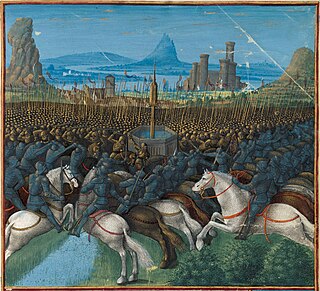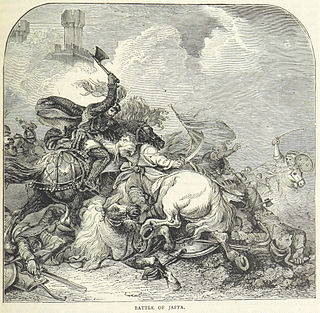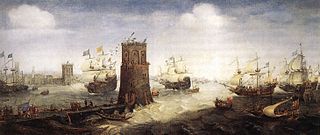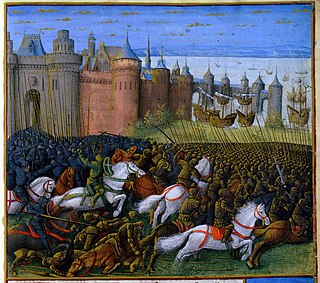 W
WThe Siege of Acre was the first significant counterattack by King Guy of Jerusalem against Saladin, leader of the Muslims in Syria and Egypt. This pivotal siege formed part of what later became known as the Third Crusade. The siege lasted from August 1189 until July 1191, in which time the city's coastal position meant the attacking Latin force were unable to fully invest the city and Saladin was unable to fully relieve it with both sides receiving supplies and resources by sea. Finally, it was a key victory for the Crusaders and a serious setback for Saladin's ambition to destroy the Crusader States.
 W
WThe Battle of Arsuf was a battle of the Third Crusade in which Christian forces led by Richard I of England defeated the forces of Ayyubid leader Saladin.
 W
WThe Battle of Cresson was a small battle, fought on 1 May 1187 at the springs of Cresson, or 'Ain Gozeh, near Nazareth. It was a prelude to the decisive defeat of the Kingdom of Jerusalem at the Battle of Hattin two months later.
 W
WThe Battle of Jaffa took place during the Crusades, as one of a series of campaigns between the army of Sultan Saladin and the Crusader forces led by King Richard I of England. It was the final battle of the Third Crusade, after which Saladin and King Richard were able to negotiate a truce. Although the Crusaders did not regain possession of Jerusalem, Christian pilgrims were permitted entry into the city, and the Crusaders were able to retain control of a sizable strip of land stretching from Beirut to Jaffa.
 W
WThe Siege of Damietta of 1249 was part of the Seventh Crusade.
 W
WJacob's Ford is a ford on the upper Jordan River where a number of bridges were built throughout history, giving rise to the medieval name Daughters of Jacob Bridge. The bridges span the last natural ford of the Jordan at the southern end of the Hula Basin between the Korazim Plateau and the Golan Heights. The ford, then the bridges, have been a crossing point for thousands of years.
 W
WThe Battle of Hattin took place on 4 July 1187, between the Crusader states of the Levant and the forces of the Ayyubid sultan Saladin. It is also known as the Battle of the Horns of Hattin, due to the shape of the nearby extinct volcano of Kurûn Hattîn.
 W
WThe Siege of Jacob's Ford was a victory of the Muslim sultan Saladin over the Christian King of Jerusalem, Baldwin IV. It occurred in August 1179, when Saladin conquered and destroyed a new border castle built by the Knights Templar at Jacob's Ford on the upper Jordan River, a historic passage point between the Golan Heights and northern Galilee. Jacob's Ford is also known by the Latin name of Vadum Iacob and in modern Hebrew as Ateret. Many scholars believe that Saladin's reconquest of the Holy Land and Jerusalem in 1187 was heralded by this earlier victory.
 W
WThe Siege of Kerak took place in 1183, with Saladin's forces attacking and being repelled from the Crusader stronghold.
 W
WThe Battle of La Forbie, also known as the Battle of Hiribya, was fought October 17, 1244 – October 18, 1244 between the allied armies and the Egyptian army of the Ayyubid Sultan as-Salih Ayyub, reinforced with Khwarezmian mercenaries. The resulting Ayyubid victory led to the call for the Seventh Crusade and marked the collapse of Christian power in the Holy Land.
 W
WThe Battle of Mansurah was fought from February 8 to February 11, 1250, between Crusaders led by Louis IX, King of France, and Ayyubid forces led by Emir Fakhr-ad-Din Yusuf, Faris ad-Din Aktai and Baibars al-Bunduqdari.
 W
WThe Battle of Montgisard was fought between the Kingdom of Jerusalem and the Ayyubids on 25 November 1177 at Montgisard, in the Levant between Ramla and Yibna. The 16-year-old King Baldwin IV, seriously afflicted by leprosy, led an outnumbered Christian force against Saladin's troops in what became one of the most notable engagements of the Middle Ages. The Muslim army was quickly routed and pursued for twelve miles. Saladin fled back to Cairo, reaching the city on 8 December, with only a tenth of his army. Muslim historians considered Saladin's defeat to be so severe that it was only redeemed by his victory ten years later at the Battle of Hattin in 1187, although Saladin defeated Baldwin in the Battle of Marj Ayyun in 1179, only to be defeated by Baldwin again at the Battle of Belvoir Castle in 1182.
 W
WThe Siege of Damietta of 1218–1219 was part of the Fifth Crusade in which the Crusaders attacked the Egyptian port city of Damietta. The city, under the control of the Ayyubid sultan al-Kamil, was besieged in 1218 and taken by the Crusaders in 1219.
 W
WThe Siege of Jerusalem was a siege on the city of Jerusalem that lasted from September 20 to October 2, 1187, when Balian of Ibelin surrendered the city to Saladin. Though Jerusalem fell, it was not the end of the Kingdom of Jerusalem, as the capital shifted first to Tyre and later to Acre after the Third Crusade. Latin Christians responded in 1189 by launching the Third Crusade led by Richard the Lionheart, Philip Augustus, and Frederick Barbarossa separately.
 W
WThe 1244 Siege of Jerusalem took place after the Sixth Crusade, when roaming Khwarazmians clans conquered the city on July 15, 1244.
 W
WThe Siege of Tyre took place from November 12, 1187 to January 1, 1188. An army commanded by Saladin made an amphibious assault on the city, defended by Conrad of Montferrat. After two months of continuous struggle, Saladin dismissed his army and retreated to Acre.